
CATCHING up on some places I haven’t been yet, I decided to go over some well-worn territory for me at least, from Astoria to Woodside. From 2012 to 2018 I often volunteered as an office boy and occasional docent at Greater Astoria Historical Society (on whose board I serve), a decade when my paid employment was sporadic as a freelancer for occasionally months at a time. My main task was to scan and label postcard and photograph collections, and this task led to the publication of my second book (co-written with GAHS) Forgotten Queens, still available from Amazon or direct from Arcadia. I would walk to Astoria from Woodside or vice versa. Today’s walk wasn’t an exact match for the route I took but it’s close. Changes have been made in 7 years, but occasionally, none whatsoever.

Beginning at Broadway and 31st Street, this corner candy store has been here a long time.. The candy store sign once read “School Supplies and Cigars.” My guess is that Hurricane Sandy reduced it to just “Lies & Cigars.” Coca-Cola originally paid for this “privilege sign.”
GOOGLE MAPS: ASTORIA TO WOODSIDE
The Department of Transportation has embarked on a lamppost replacement project on 31st Street which is about halfway done. Under elevated trains, the DOT has recently been going with Dwarf Davit poles, with curved shafts. However on 31st Street the el is narrower than the street in many areas, so is employing these hybrid poles, only a bit shorter than usual and with detachable shafts. Oddly these poles are painted gray on their bases and about 1/3 up the poles. As is the usual case with these posts, the date of installation, in this case 2024, is stamped into the metal.
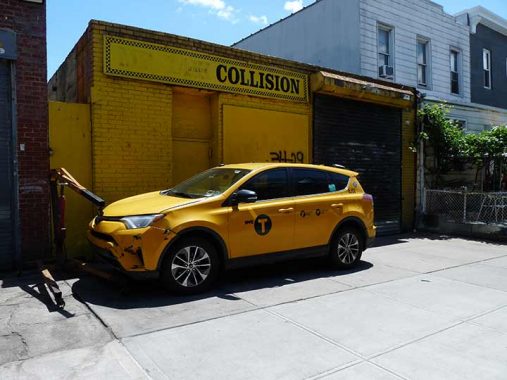
I was fascinated with the taxi repair shade of yellow and the one on the cab itself. If you look carefully you can tell by this contrast that NYC cabs are actually orange yellow instead of pure yellow.
They probably won’t last much longer but a few of 31st Street’s 1960s-era lamps are still standing. They have cylindrical shafts, detachable masts and (for NYC) nonstandard bases. See ’em while you can!
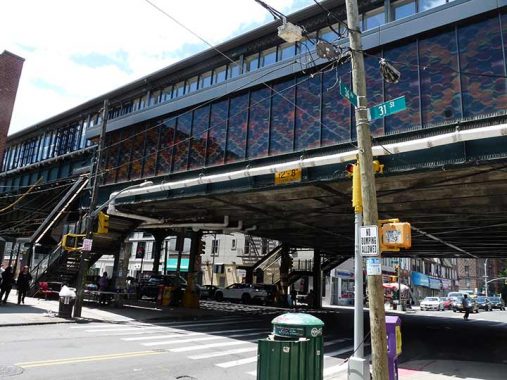
In 2018, the elevated stations on 31st Street received masterful makeovers, making them the handsomest elevated stations in the system, with innovations like waiting lounges and transparent mylar walls as well as new artwork. This is the 36th Avenue station, and this page features looks at the new stations in detail.
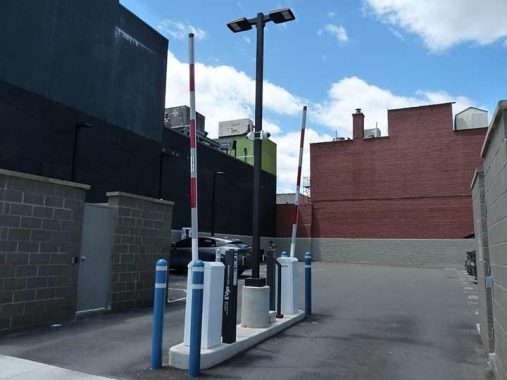
Despite the increasing popularity of electric vehicles, I’ve not seen many charging stations around town; I discovered one here at 36th Avenue and 33rd Street run by EvGo which has about 1000 such facilities nationwide. The charging stations take up less room than modern gas stations.
My camera gravitates toward brick residential complexes or factories, like this one on 33rd between 36th and 37th Avenues. I don’t know its original purpose, but its exterior is decorated by stamped metal signs warning against defacing the property.

Across 33rd Street is this massive structure, now a residential complex called CityPoint. Its website states that this was once a Brooks Brothers clothing factory. In the 1940s, though, it was a hosiery factory, either before or after Brooks Brothers took over. Since there were other clothing factories in the area, the building shown above may also have been one of those.

I had thought that the Melrose Ballroom, and event/concert venue on the same venue, was crafted from an older factory building, but it seems to be new construction.
More and more imaginative storefront signage has been appearing the last couple of decades, such as Dive Bar LIC and Elios pasta and dessert shop.
Pig Beach, the popular barbecue restaurant was actually having a chili cookoff event that day I passed by, on 36th Street off 36th Avenue. The restaurant is named for an island in the Bahamas populated by feral pigs, which has become a tourist attraction. The fare and venue look good and I may stop in sometime.
The factory building now hosting the restaurant was once occupied by Hygrade Products; the only Hygrade I am familiar with was a hot dog brand, but the name is and was also used by many other concerns.
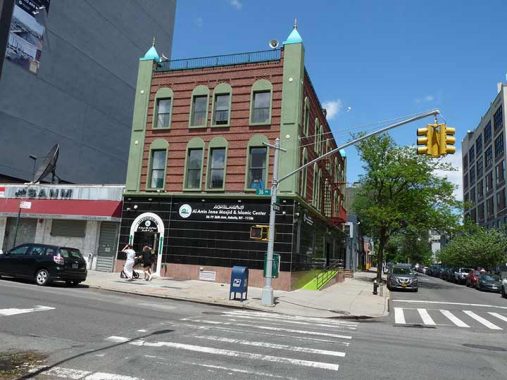
The building on the NW corner of 36th and 36th started out rather drab but the Al-amin Jame Masjid and Islamic Center has made considerable improvements over the past three years.
Meanwhile, on the northeast corner, this all-business brick building, which was built after 1940s, has some service shops on the ground floor and on the upper floors, the offices of JUS Broadcasting:
A home of five TV channels and a radio station. Jus Broadcasting Corp entered the market in 2007 with launch of its flagship channel Jus Punjabi TV in the United States. Since then Jus Broadcasting Corp. has launched a bouquet of TV channels, collectively referred as Jus TV. Today JUS Broadcasting channels reach a worldwide audience broadcasting in the USA, UK, Europe, Canada, Australia, New Zealand and even back home in India. All our content is shot and broadcast in HD. [JUS]
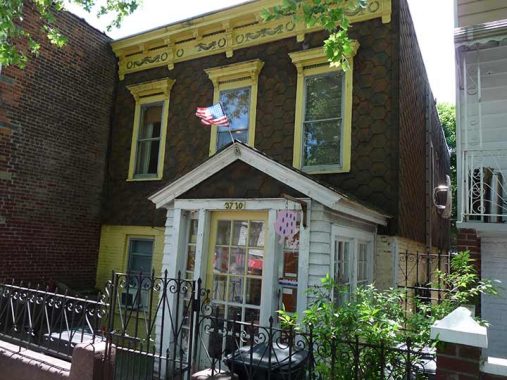
A rarity at least on the main streets in Astoria, #37-10 36th Avenue looks much like it did in 1940.
Nearby: still-standing Pierce-Arrow Factory
36th Avenue’s eastern progress is blocked by Northern Boulevard, which skirts the northern end of Sunnyside Yards. Speaking of colorful exteriors, here is the rainbow’ed front of Colombian restaurant La Choza Del Gordo (“The Fat Man’s Shack”) at Northern Boulevard, 36th Avenue and 41st Street.
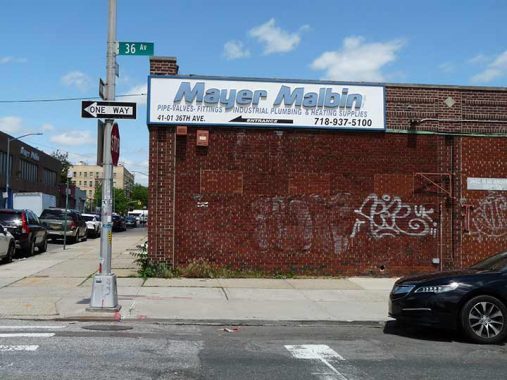
I was drawn to the plastic-lettereed sign for pulbing and heating supplies manufacturer Mayer Malbin at 36th Avenue and 41st.
Northern Boulevard in LIC is Auto Row with numerous repair shops, parts suppliers, gas stations, and used car dealers like Major World with its loud radio commercials. In 1999, I briefly worked at Standard Auto Parts on Northern Blvd. and the 36th Street subway stop.
Hearthstone, a large apartment complex and Northern Blvd. and 45th Street, makes a considerable impression: no nearby building approaches it in height. New York YIMBY has some interior photos.
A block away, on 46th Street, is a former Packard Auto showroom, which has changed appearance considerably recently. FNY covered it in May 2025.
Diners are my happy place and I try to have lunch at a classic diner — at least eventually — whenever I see one. I moved to Little Neck in 2007 and down the street was the Scobee, which became my once per week home office. But diners are endangered. Large menus are hard to maintain, the business is not easy, and is not being handed down with generations, as owners’ children want to do something else with their lives. The Scobee was gone by late 2010.
I’m perplexed why I haven’t yet been in the New York Diner, Northern Blvd between 49th and 50th, but one of these days…maybe. New York Diner, known previously as the Blue Crystal and Ham & Eggery, was built in 1949 by the Mountain View company of Singac, NJ, which was in existence between 1939 and 1957. Several Mountain Views are scattered around in NYC and across the country. Kevin James and company filmed an episode of The King of Queens here on Sept. 29, 2001. We visited it on a Forgotten NY tour in 2020.
Tower Square, Northern Boulevard and Woodside Avenue, boasts possibly the most distinctive building on Northern Blvd. west of the Roslyn Clock Tower. It was the subject of the very first Forgotten NY page I ever composed in 1998, using Adobe Pagemaker.
William Steinway, the piano manufacturer, electrified his Long Island City streetcar line, the Steinway Railway Company, and hooked up with developer Cord Meyer’s Newtown Railway Company, which extended to Corona, in 1894. Two years later, the lines reorganized as The New York and Queens County Railway Company and built a handsome, twin-spired brick depot at Northern Boulevard and Woodside Avenues. Trolleys would ply these roads to Queens’ eastern sections. Steinway, for his part, actually built a tunnel to take trolleys into midtown Manhattan on 42nd Street, but they went unused for two decades before they were reactivated as part of the IRT Flushing Line when it opened in the early 1910s.
Trolley service out of this depot ran from 1894 until September 1937, when buses took over. The eastern end of the building was torn down in 1930 after a fire. Over the decades, the old trolley barn was deserted and was in danger of demolition until it was preserved in 1987 as part of the Tower Square Shopping Center. Above the arched entrance you can still find an emblazoned “N.Y. and Queens County Ry. Company” and “Waiting Room.”
Today was fortuitous, as I have rarely found the sun in a good spot to get pictures of the building out of shadows. The pizza place called “The Rail Yard” has closed and the building seeks a tenant.
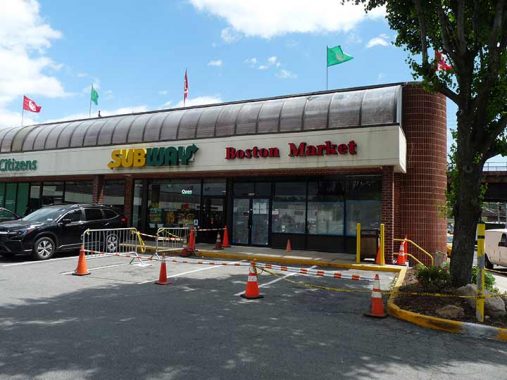
A tale of two franchises at Tower Square, as Subway is still thriving but Boston Market has failed.

This small building on Woodside and 37th Avenue was apparently once a streetcar waiting room, as it boasts another “N.Y. and Queens County Ry. Company” sign. It is home to a laundromat and small breakfast spot. 1940s NYC is silent about its past.
Unfortunately NextGen wasn’t cooperating with these photos, so I used GMedia, which slaps these labels under the photos: bear with me.
I have rarely walked 38th Avenue, a narrow lane running north of the LIRR from Woodside Avenue east to 58th Street. Old maps call it Howell Avenue and it’s missing sidewalks in spots. It’s sort of the Land that Time Forgot though at 55th Street there’s a newer, 30-year-old building. Even that was empty after it was built for a few years.

I like a “busy” telephone pole, with dozens of electrical, telephone and TV cable wires. And this one still has an old style scrolled fire alarm indicator mast. In the 1950s these were fashioned out of former street lamp masts that had radial wave lighting fixtures.
The small house at 57th Street and 38th Avenue has changed quite a bit since 1940, but none of the exterior changes are any good: most of its windows have disappeared.

Woodside was largely a woodsy swamp until the mid-1860s, when developer Benjamin Hitchcock purchased the John Kelly farm and divided it into building lots located along today’s Woodside Ave. Kelly, an early settler, was part owner of a Brooklyn newspaper and sent it dispatches from his home in the “sticks” called “Letters from Woodside;” Hitchcock perpetuated the name. Woodside took off when the Queensboro Bridge opened in 1909 and the el arrived in 1917. Woodside’s strange street pattern, with some streets angling for seemingly no reason, has to do with its old railroads: the Flushing and Woodside and Flushing and Northside Railroads, as well as the Long Island Rail Road, all ran through Woodside. By the late-19th century, the railroads had either failed or absorbed by the LIRR. The surviving roads, absorbed into the LIRR, were elevated by 1917.
Today in Woodside you’re just as likely to exit an Irish bar and enter an Indian restaurant as you are to walk out of a bodega and then past a remnant of the colonial era. Woodside has succeeded in hiding in plain sight some of its more prominent relics from the old days, too.
Beside the railroad overpass west of the LIRR Woodside station, is a shambling, two-story residence that gives just a little hint of past grandeur. For several decades, this was a hotel that sat beside the railroad tracks, which were at grade when the house was built in 1882.
The hotel was constructed by German immigrant John Meyer, who arrived in Queens in 1877. He gained employment as a bartender/manager at a local watering hole called the Woodside Pavilion, which still stands as an unprepossessing private dwelling with white aluminum siding and brown window shutters, a block away at 39th and 57th. Meyer intended to become a saloon owner/hotelier and had Meyer’s Hotel constructed for $10,000 in 1882, with then-modern amenities private baths, running hot and cold water, modern kitchen, barber shop, and a livery service. Much of the cost went into sumptuous appointments such as yellow hardwood pine floors, black walnut moldings and paintings by renowned local artists.
Meyer was not around long to savor the hotel’s success, dying of a heart attack in 1887. His widow Katherine remarried, to George Shreiner, and kept the business going as the Katherine Meyer Hotel, which was later taken over by John E.A. Meyer, John and Katherine’s son.
As the decades went by Woodside was losing its rural aspect. The city was coming to Queens, and the LIRR eliminated its grade crossing and added extra tracks to its main branch, which wound up passing in front of Meyer’s Hotel. A massive elevated trestle was built over the building’s front gate. John E. A. Meyer closed his father’s hotel in 1917, the year after the trestle opened, and it became a two-family house. It’s likely that the current residents have no idea the place used to be one of the jewels of Woodside hospitality.

Next door to the old Meyer’s Hotel building on 39th Ave. is the former home of the Woodside Hook and Ladder Company. The fire brigade, formed in May 1878 as Newtown Fire Department Company #3, originally built a firehouse on Woodside Ave. and 60th St., but outgrew what was a small building and raised the money to build a new firehouse on Riker Ave., now 39th. The new firehouse was dedicated on November 17, 1884. The building came to be known as the Truck House or Firemen’s Hall, and became a community center next to the then-handsome Meyer’s Hotel, hosting community fundraisers and socials.
As early as 1895 Lutheran services were held in the building. The fire company was disbanded in 1913 and the Truck House has had many diverse uses since then, serving as a post office, and American Legion Hall, and currently, the Bethel Elevation Community Church. the inscription “Pengikut kristus berani tampil beda” is in Indonesian and means “Followers of Christ dare to be different.”
Though the old building at St. Paul’s Episcopal Church, 39th Avenue and 61st, suffered a fire in 2008, services were held in the newer adjoining building, but I found it up for sale in 2025.
Check out the ForgottenBook, take a look at the gift shop. As always, “comment…as you see fit.” I earn a small payment when you click on any ad on the site.
5/26/25

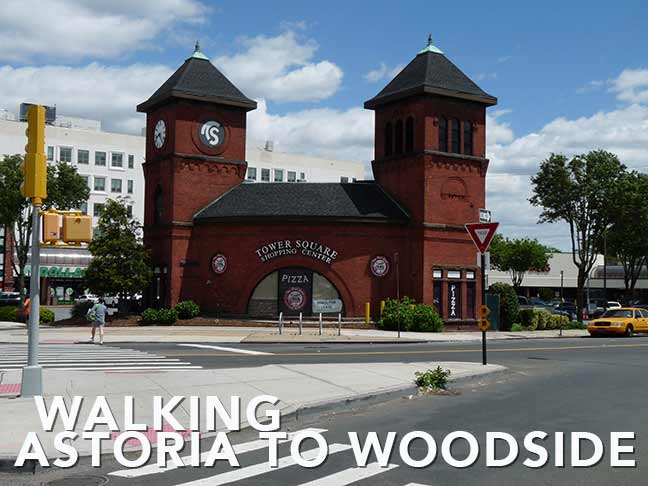
10 comments
The paint on the street light pole is part of a very sad story. A young women named Jodie Lane was out walking her dog. The dog stepped on a Con Edison manhole cover and began shaking from electric shocks. When Ms. Lane attempted to rescue her dog, she received a fatal shock. Both the City and Con Edison took action to prevent a recurrence of this tragedy. Con Edison began periodic testing of every manhole cover, traffic and streetlight pole. NYC embarked on a program to paint every existing pole and new poles subsequently installed, with a coating of insulating paint up to a level of seven feet above the ground. Since the Cooper Lighting fixture changeout starting in 2007, and through to the led relighting program, all streetlighting fixtures are equipped with
a current leakage sensing circuit to detect wiring problems that might lead to an energized pole.
While it is hard to see, there is a small led that lights up red if there is a problem. It is located on the fixture between the main led light and the arm of the pole. I was out one evening walking when I noticed a streetlight flashing on and off about two blocks away. When I got to the pole I noticed that the streetlight and the red voltage sensing led were alternately flashing. I am a retired electrician, so I always carry a non contact voltage tester in my shirt pocket. Sure enough, my tester indicated that the current leakage circuit on the streetlight was working. The pole was energized. Had anyone touched the pole where the insulating paint was missing they would have received at least a shock, if not something worse. I called the pole location to 311. For a complaint of an illuminated red led on a fixture, the contractor has a four hour response time.
I’ve heard that Indonesian is one of the easiest languages to learn, even though as you can see from the church sign the vocabulary is very different from English. It has very simple grammar with no noun declensions, verb tenses, tones, or other unfamiliar elements
You should realize & accept the fact that “diners” are a thing of the past, as are “candy stores”, luncheonettes”, & “drugstores with soda fountains”. Due to the high cost of commercial rents only restaurant chains survive. They’re located at malls because that’s where the parking spaces are. Examples of sucessful chain operations are IHOP (International House of Pancakes), & local & regional chain restaurants like Panera, First Watch, Pei Wei. These are all breafast & lunch type operations that are thriving where I live in AZ. Accept the fact that you live in one of those coastal bubbles that time is passing by because their governing class refuses to provide adequate opportunity, public safety & education. The USA is a majority middle class country, & this makes us a unique society. Ignore this at your own risk. Remember also: “if you can build a better mousetrap, the world will beat a path to your door”.
Many restaurant chains are struggling. Boston Market and Ruby Tuesday’s are nearly gone; TGI Fridays, Red Lobster and Denny’s are closing many stores; Cracker Barrel and Applebees are showing signs of weakness, all this is just to name a few.
Rumors of the diner’s demise are greatly exaggerated (https://www.theinfatuation.com/new-york/guides/best-diners-nyc for example). Our webmaster points out that many families don’t keep them alive, but younger generations are reviving the format in their own way.
The closure of “diners”, “luncheonettes” and many other stores are due to many factors, not only parking. What people eat, where they eat it and how they eat it are always evolving. The following are some of the most well-known chain restaurants that have recently closed most locations or are completely gone: Boston Market, Red Lobster, T.G.I. Fridays, Applebee’s, Hooters, Outback Steakhouse and Denny’s. Most of these had ample parking for their customers. Folks who never used delivery apps before the Covid pandemic now use them often instead of eating out. Yes, the high cost of rent is a problem, but it is the same problem for chains as it is for small, independent restaurants.
The high cost of food has hit people both at home and in restaurants, causing many to cut back on dining-out.
If you think that small, independent restaurants are a thing of the past, I suggest you watch a few episodes of “Diners, Drive-Ins, and Dives”.
I’m familiar with the many chain restaurant closures. A common factor seems to be over-expansion. The terrible events that characterized the period of 2021-2024, COVID-iocy, unchecked criminality, & inflation surely didn’t help, either. And then there’s Denny’s…Our local Denny’s had everything in it’s favor: a great location on a main thoroughfare, abumdant parking & population growth. However, the customer service went from inconsistant to practically non-existant. It finanlly closed earlier this year (a mercy killing?). The existing structure could be remodelled & tranformed into something like a chiropractic clinic since there’s a nearby dental office in the same strip mall & it could help relieve the pain caused by so many years of watching the San Tan Valley Denny’s roll over & play dead.
Woodside from Woodside Ave to 61st Street and Woodside Ave to N. Blvd should really be landmarked. There are some incredibly old and attractive houses that are sitting covered in vinyl. Unfortunately, we lose more and more each year.
I love that mosque on 36th and 36th. The upper floors look like a set piece from a western with Islamic touches.
CityView Plaza used to be the home of Hagstrom Map for several years after they left their Maspeth digs, when they were still under the Langenscheidt publishing company umbrella.
The old Hook and Ladder Company building isn’t exactly “next” to the Meyer Hotel; there’s a house with three stone garages between them. I grew up in that house, and we were told that it was originally the coachmen’s house for the hotel. That’s why it had the garages, as they were built as stables for the carriages. Our house had fixtures for gas lighting in a lot of the rooms, and the gas lines were still charged when my family moved in.